Salvia holwayi
|
![]()
Links to Other World of Salvia Pages:
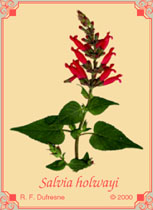 |
Holway's Sage This is a lush, dense bedding plant with rich green foliage and brilliant red tubular flowers. It should be ideal for the warmer coastal areas of the United States. Since it is late blooming, it is mainly useful as a winter-blooming conservatory plant in colder areas. It will easily fill a big hanging basket. It is related to S. involucrata, S. karwinskii, S. wagneriana, and S. puberula (section Cardinales) ©2000 by Richard F. Dufresne |
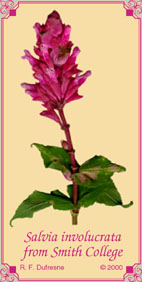 |
Flamingo Sage The true identity of this plant needs to be determined. Since it has a maroon band around the nodes like the white-bracted form of S. wagneriana and is otherwise very similar, it may actually be another form of the latter. In any case, this winter-blooming tall sage is quite striking. The flowers are a brilliant pastel pink and the involucre of bracts form something of a cylinder with a pointed tip, suggesting a lipstick tube (so you could also call it Lipstick Sage). The floral leaves enter the display, often being irregularly variegated a cream white. The plant in bloom could be effective camouflage for a flamingo, hence its common name. It is a favorite winter bloomer in the greenhouses of Smith College. It is related to S. holwayi, S. karwinskii, S. wagneriana, and S. puberula (section Cardinales) ©2000 by Richard F. Dufresne |
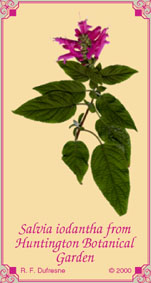 |
Huntington Botanical Garden Mexican Fuchsia Sage This selection of fuchsia sage has a dense stubby flower spike ending in a five-fold symmetric terminal (peloric) flower. It is slow to bloom, and should be used as an outside plant only in the warmer coastal states. In form, it is like an upright pineapple sage. The foliage develops a burgundy cast in strong sunlight. Other forms are the Southwest Native Seeds and the Louis Saso selections. All forms of S. iodantha are valued as hummingbird plants in the Gulf coastal areas. ©2000 by Richard F. Dufresne |
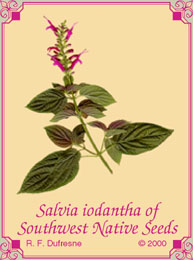 |
Southwest Native Seeds Mexican Fuchsia Sage Though not as showy as the other two selections (Louis Saso and Huntington Botanical Garden forms), it is the hardiest and the first to bloom. It is also the form that develops the most intense burgundy coloration in its foliage and is the most compact. All forms of S. iodantha are valued as hummingbird plants in the Gulf coastal areas. ©2000 by Richard F. Dufresne |
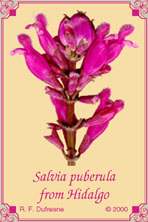 |
Hairy Roseleaf Sage This is the most resilient and hardy selection of the roseleaf sages. It has survived four years for me in a garden abandoned to weeds like Johnson grass with no fertilization and protection from freezing. It is the earliest to bloom (mid summer) and has an erect growth habit. The involucre is nearly spherical in shape, unlike the similar selection from Yucca-Do, which is elongated. The name comes from the hairy foliage that emerges from its base earlier than that of other cultivars in cool spring weather. This plant was collected 30 miles south of the type location further up the Pan-American highway in Hidalgo, at about a 800 foot higher elevation. It is related to S. holwayi, S. karwinskii, S. wagneriana, and S. involucrata (section Cardinales) ©2000 by Richard F. Dufresne |
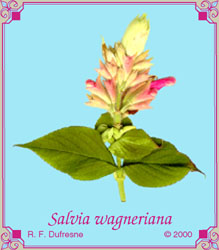 |
Wagner's Sage This plant gets quite large and is hard to tell apart from the Smith College S. involucrata unless it is in bloom. All parts of the floral display besides the calyx and flower are a creamy white. It has a maroon band around the leaf nodes on its stems. Since it is a tender winter bloomer, it is best set outside in parts of the United States that get no colder than 25° Fahrenheit. As a conservatory plant, it can be stunning with the three-way contrast of the pink flowers, white bracts, and rich green foliage. It should be spectacular along the southern Atlantic and Gulf coastal areas. It is related to S. holwayi, S. karwinskii, S. involucrata, and S. puberula (section Cardinales) ©2000 by Richard F. Dufresne |
Links to Other World of Salvia Pages:
![]()